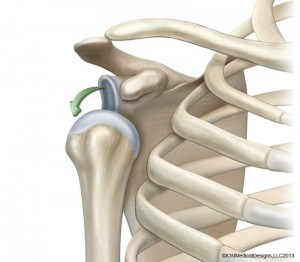Shoulder Dislocation
A shoulder dislocation occurs when the humeral head (ball part) of the shoulder is displaced from the glenoid (cup part of the shoulder). It usually slips forward (anterior) and down (inferior). It usually occurs by force, often when the arm is jerked backward. It can also be caused by landing on an outstretched arm or by striking the arm. Dislocations cause loss of motion, pain, and deformity of the shoulder. A so-called subluxation is a partial dislocation. The head slips onto the lip of the shoulder then often slips back.
Often the first dislocation requires someone to help you put it back into place. This first dislocation is often treated by medications and physical therapy. Subsequent dislocations are treated based on frequency, age of the patient, and severity. Younger patients who have a dislocation are much more prone to subsequent dislocations, than if the patient is 40 y/o or more when having their first dislocation. When surgery is required, it often can be done arthroscopically unless there is significant bony damage to the glenoid of the joint which may require open procedures.
